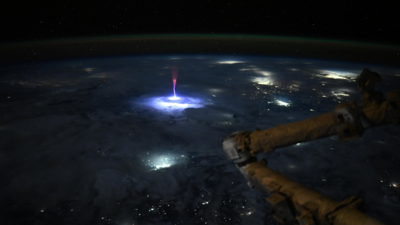Astronaut Captures Elusive Red "Sprite" in Space, Aiding Atmospheric Research
While orbiting high above North America, NASA astronaut Nichole Ayers captured a rare and stunning sight: glowing red lights shimmering in Earth’s upper atmosphere. This phenomenon, known as a Transient Luminous Event (TLE) or "sprite," appeared as a brief burst of red light above thunderstorms over Mexico and the United States.
 *Astronaut spots red sprite above Earth.*
*Astronaut spots red sprite above Earth.*
Sprites are a type of TLE, characterized by a brief flash of red light that occurs high above powerful thunderstorms. These massive bursts of electrical energy can reach up to 100 kilometers above Earth’s surface and consist of “cold plasma,” similar to the glow inside a fluorescent light tube, rather than typical lightning.
Due to their high altitude and short duration, sprites are rarely visible from the ground, making Ayers’ space-based capture particularly significant.
Sharing the image on X, Ayers exclaimed, “Just. Wow. As we went over Mexico and the U.S. this morning, I caught this sprite.”
"Sprites are TLEs or Transient Luminous Events, that happen above the clouds and are triggered by intense electrical activity in the thunderstorms below," she explained.
Sprites have fascinated scientists and pilots for years. These brief, jellyfish-shaped flashes shoot upward into the atmosphere and vanish in milliseconds. For nearly a century, pilots reported seeing them, but many scientists dismissed them as myths or optical illusions. This perception shifted in 1989 when the first clear image of a sprite was accidentally captured on camera.
According to NASA, sprites occur when strong lightning discharges interact with Earth’s ionosphere. As the discharge travels upward and hits nitrogen molecules, it produces a reddish glow. Sprites belong to a larger group of upper-atmosphere phenomena that includes blue jets and red elves.
The post sparked amazement and curiosity among users. One commented, "Sprite.... one of the rarest of rare celestial phenomenon.”
Another user inquired, “How long do the sprites last? Is this a still shot taken from a video? What altitude did this one reach? The more we find out, it becomes obvious we know far less than we thought.”
Newer articles
Older articles
 Indian Astronaut Joins ISS: Shukla's Mission Ushers in New Era for India's Space Program
Indian Astronaut Joins ISS: Shukla's Mission Ushers in New Era for India's Space Program
 Ashada Gupt Navratri 2025: Unveiling Dates, Sacred Rituals & Hidden Significance
Ashada Gupt Navratri 2025: Unveiling Dates, Sacred Rituals & Hidden Significance
 Rishabh Pant's Unconventional Batting Redefining Cricket, Says Greg Chappell
Rishabh Pant's Unconventional Batting Redefining Cricket, Says Greg Chappell
 Moto G54 Price Slashed in India: Check Out the New, Lower Cost
Moto G54 Price Slashed in India: Check Out the New, Lower Cost
 'The Traitors' Star Apoorva Mukhija Accuses Sudhanshu Pandey of Misogyny and Verbal Abuse After On-Screen Drama
'The Traitors' Star Apoorva Mukhija Accuses Sudhanshu Pandey of Misogyny and Verbal Abuse After On-Screen Drama
 JPG to PDF: A Graphic Designer's Guide to File Conversion and Quality Preservation
JPG to PDF: A Graphic Designer's Guide to File Conversion and Quality Preservation
 Van der Dussen to Captain South Africa in T20I Tri-Series Against New Zealand and Zimbabwe
Van der Dussen to Captain South Africa in T20I Tri-Series Against New Zealand and Zimbabwe
 England's Audacious Batters Claim They Could Have Chased Down 450 in First Test Win Over India
England's Audacious Batters Claim They Could Have Chased Down 450 in First Test Win Over India
 20 Minutes to a Healthier Brain and Heart: Neurologist's Simple Strategies to Combat Cholesterol, Blood Pressure, and Dementia Risk
20 Minutes to a Healthier Brain and Heart: Neurologist's Simple Strategies to Combat Cholesterol, Blood Pressure, and Dementia Risk
 Popular Finance YouTuber "financewithsharan" Hacked: Security Measures to Protect Your Account
Popular Finance YouTuber "financewithsharan" Hacked: Security Measures to Protect Your Account